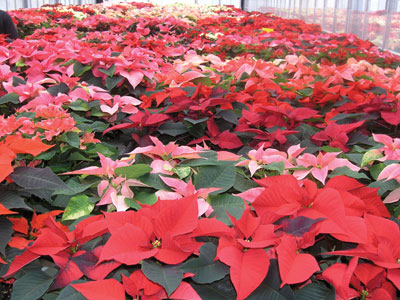
Sunlight and Day Length Control: The poinsettia crop should receive as
much sunlight as possible. Adequate spacing, clean glazing, and nothing
overhead are important for the growth and quality of poinsettias.
Sunlight and Day Length Control: The poinsettia crop should receive as much sunlight as possible. Adequate spacing, clean glazing, and nothing overhead are important for the growth and quality of poinsettias.
 |
|
| Tracking weekly height of the crop provides an important decision aid. Advertisement
|
If the poinsettia crop is going to be delayed with long days, the long-day lighting should begin on Sept. 1 to make sure plants remain vegetative. Lighting from 10 p.m. to 2 a.m. each night best provides long days.
If the poinsettia flowering is going to be accelerated, plants should receive black cloth treatment from 5 p.m. until 8 a.m., making sure there are no light-leaks in the shade-out curtains. If natural day flowering is used, make sure there are no stray lights on in the greenhouse at night after Sept. 1. This means the grower should visit the greenhouse during the night to make sure the poinsettia crop is not being exposed to stray lights.
Watering and Fertilizer: Poinsettias should not be stressed to the point of wilting before water is applied, but they should also dry out between watering. With a drip system, water should be applied for a short time to allow the top of the container to be wetted, wait a short period, and then apply enough water until drainage occurs.
THOROUGHLY WATER PLANTS AT EVERY WATERING
■ Plants should be thoroughly watered at every watering. Poinsettia should receive moderate to heavy feed with a poinsettia fertilizer formulation. Supplying adequate calcium and magnesium is important to the poinsettia crop. Early application of fertilizer containing ammonium (from potting until Oct. 1) can be important in stimulating the early growth of the more compact poinsettia cultivars.
The light leaf poinsettia cultivars require a higher rate of fertilizer than the dark leaf poinsettia cultivars.
Periodically apply a higher rate of fertilizer (300 ppm N) or add a slow-release fertilizer as a top dress to the light leaf cultivars when growing together with the dark leaf cultivars will provide the required higher fertility.
I strongly recommend root medium sampling with a complete root medium analysis at least monthly to monitor the pH and nutrient levels of the poinsettia crop. With a root medium analysis, nutrient levels can be adjusted before they become a problem affecting plant growth.
Temperature: Do not save on fuel cost by lowering temperature during the early growth of poinsettias.
Temperatures of 70-75ºF (21-24ºC) day and 67ºF (19.5ºC) night are essential for early growth of poinsettias under most growing conditions. I would not suggest lower temperatures unless the grower has experience of success with cooler growing temperatures.
CONSULT WITH THE BREEDER WHEN CONSIDERING ‘COOL FINISH’
■ The cool finish of poinsettias to save heating costs is, however, possible when planned in advance as a production strategy with specific cultivars. I would suggest growers consult with the poinsettia breeder when considering cool finish of particular cultivars.
Insect and disease control: Growers should use an integrated pest management approach to both insect and disease control in poinsettia production. Yellow sticky cards are a must for monitoring insects.
Scouting the plants weekly for insects and diseases will allow a quick response to deal with problems before they become large. Scouting requires that growers “walk the crop,” touch and feel the plants, and look at the root systems on the plants. All unknown problems should be identified quickly. Problems don’t correct themselves. Delaying response, treating a problem with a wrong chemical, or incorrect approach to correcting a problem will only make the problem worse and increase the cost to correct it.
Graphical Tracking: Tracking the weekly height of the poinsettia crop provides the grower an important decision aid. I do think growers should adjust the standard growth curves to fit their specific greenhouse, cultivar and container size. These adjustments can be made with growth data from previous years.
BE PREPARED TO MAKE ADJUSTMENTS
■ It is also very important to make adjustments weekly in production to account for growth differences between the observed height and the standard curve. Below or above the standard curve in October is much more difficult to correct in November.
 |
|
| Dr. P. Allen Hammer
|
PGRs, DIF, Morning Dip: All three can be used to increase or decrease stem elongation of poinsettias.
Higher rates of PGRs application should be made before Oct. 1 in northern production areas. Later applications will result in delayed bract development as well as reduced bract size.
DIF can be used for small increase or decrease in stem elongation later in production in cooler production areas without an effect on bract development. A morning dip may be the most effective way of providing the DIF to reduce stem elongation.
The morning dip (reducing temperature 5-10ºF) should start one hour before sunrise and last until one hour after sunrise to be effective. Micro drenches of Paclobutrazol (0.1-0.5 ppm) can also be used later in production to reduce elongation in poinsettia without delaying bract development when used correctly. This technique should only be used with experience and/or advice from a trusted source.
Dr. P. Allen Hammer is involved with product development and support with Dümmen U.S.A. He is professor emeritus of floriculture, Department of Horticulture, at Purdue University
Print this page